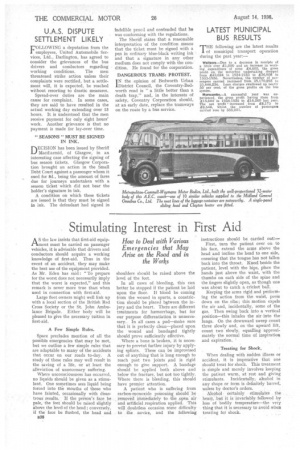Stimulating Interest in First Aid
Page 44

If you've noticed an error in this article please click here to report it so we can fix it.
How to Deal with Various Emergencies that May Arise on the Road and in the Works
AS the law insists that first-aid equipment must be carried on passenger vehicles, it is advisable that drivers and conductors should acquire a working knowledge of first-aid. Thus in the event of an accident, they may make the hest use of the equipment provided. As Mr. Eden has said : "To prepare for the worst does not necessarily imply that the worst is expected," and this remark is never more true than when used in connection with first-aid.
Large fleet owners might well link up with a local section of the British Red Cross Society or the St. John Ambulance Brigade. Either body will be pleased to give the necessary tuition in first-aid.
A Few Simple Rules.
Space precludes mention of all the possible emergencies that may be met. but we outline a few simple rules that are adaptable to many of the accidents that occur on our roads to-day. A study of these rules may well result in the saving of a life, or at least the alleviation of unnecessary suffering.
Where unconsciousness has occurred, no liquids should be given as a stimulant. One sometimes sees liquid being forced into the mouths of those who have fainted, occasionally with disastrous results. If the person's face be pale, the feet should be raised slightly above the level of the head ; conversely, if the face be flushed, the head and B38 shoulders should be raised above the level of the feet.
In all cases of bleeding, this can better be stopped if the patient be laid upon the floor. If blood be coming from the wound in spurts, a constriction should be placed bstween the injury and the heart. There are different treatments for hxmorrhage, but for our purpose differentiation is unnecessary.. In all cases a pad—make sure that it is perfectly clean—placed upon the wound and bandaged tightly should prove sufficiently effective.
Where a bone is broken, it is necessary to prevent further injury by applying splints. These can be improvised out of anything that is long enough to reach past two joints and is rigid enough to give support. A bandage should be applied both above and below the fracture, but not too tightly. 'Where there is bleeding, this should have premier attention.
A patient who is suffering from carbon-monoxide poisoning should be removed immediately to -the .open' air and artificial respiration applied. This will doubtless" occasion some difficulty to the. novice, and the following instructions should be carried out:—
First, turn the patient over on to his face, extend the arms above the head and incline the head to one side, ensuring that the tongue has not fallen back into the throat. Kneel beside the patient, level with the hips, place the hands just above the waist, with the thumbs on each side of the spine and the fingers slightly open, as though one was about to catch a cricket ball.
Keeping the arms rigid and performing the action from the waist, press down on the ribs ; this motion expels the air and, incidentally, some of the gas. Then swing back into a vertical position—this inhales the air into the lungs. On the downward sweep count three slowly and, on the upward lift, count two slowly, equalling approximately the normal time of inspiration and expiration.
Treating for Shock.
When dealing with sudden illness or accident, it is imperative that one should treat for shock. This treatment is simple and merely involves keeping the patient warm, at rest and giving stimulants. Incidentally, alcohol in any shape or form is definitely barred, unless by doctor's orders. . Alcohol certainly stimulates the heart, but it is invariably. followed by loss of bodily temperature—the very thing that it is necessary to avoid when treating for shock.












































































